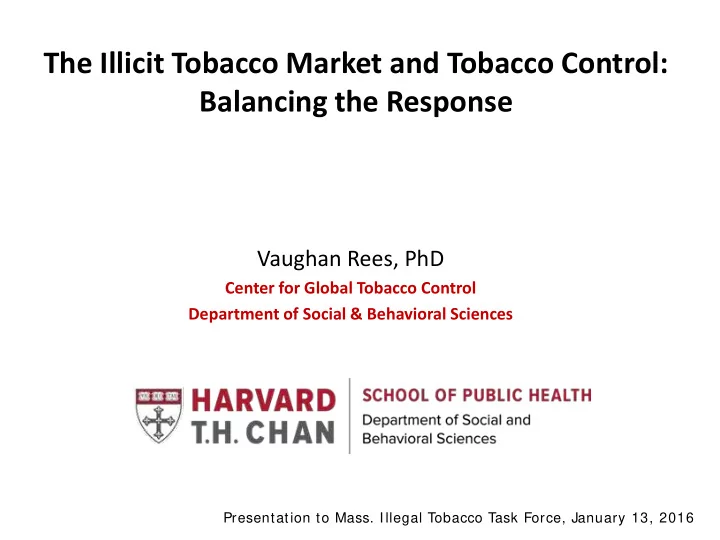

The Illicit Tobacco Market and Tobacco Control: Balancing the Response Vaughan Rees, PhD Center for Global Tobacco Control Department of Social & Behavioral Sciences Presentation to Mass. Illegal Tobacco Task Force, January 13, 2016
Tobacco a Risk Factor for 6 of the World’s 8 Leading Causes of Death WHO: NMH Fact Sheet; June 2009
Institute of Medicine, 2015: Understanding the Illicit Tobacco Market • Congressionally mandated report from the National Research Council and Institute of Medicine • Took an international perspective • Experts from economics, criminology, law enforcement, sociology, public policy & public health • Held public meetings & assessed available evidence • Interest in effect on illicit market of a potential regulatory approaches
Supply-side moderators Product/brand characteristics • Taste, flavor • Nicotine delivery • Brand image, prestige, etc. • Mentholation Supply chain Presence of illicit • Price/value • Ventilation products Enforcement Regulation/Policy Presence of licit alternatives Industry Regulation of product/ brand Quit altogether Switch to licit alternatives Overall appeal of Magnitude of Overall appeal of product/brand change in product/brand AFTER regulation product appeal Switch to illicit product BEFORE regulation (e.g., original product) Continue using product Demand-side moderators User characteristics • Demographics: e.g., ethnicity, income • Acceptability of alternatives • Nicotine dependence • Nicotine dependence • Brand loyalty • Intentions/opportunities to quit • Peer/social acceptability • Brand loyalty • History of product/brand use • Acceptability of illicit use (including prior personal & peer illicit use)
Major Conclusions • 4 main schemes: – Bootlegging – Large-scale smuggling – Illicit whites – Illegal production • Bootlegging driven by price factors • U.S. illicit tobacco market: Estimated range = 8.5 – 21% of market = 1.24 – 2.91 billion packs = $2.95 – $6.92 billion lost state / local tax revenue • Committee’s estimate is 8.5% (up from 3.25 in 1992/3) • Massachusetts a net importer of illicit tobacco
Major Conclusions • Future product regulations unlikely to have major impact on illicit market – Fire-safer cigarettes in Massachusetts – Possible future regulations on: • Menthol • Flavors • Nicotine level • Graphic health warnings
Major Recommendations • Opportunities exist at multiple levels to control bootlegging: – Digital tax stamps with encrypted information – Track & trace technologies implemented across state borders – Tax harmonization program – Appropriate tobacco -specific law enforcement response – Collaboration across jurisdictions – Agreements with tobacco manufacturers – Public education
Illicit market response must be balanced with tobacco control measures • Tobacco perpetuates poverty, impedes economic development • Globally, > 1 billion deaths projected for this century (8 million/year by 2030)* • Each smoker loses 13.2 – 14.5 years of life* • Globally, members of poorer communities have highest smoking rates • Vicious cycle of poverty and tobacco use * Eriksen et al. The Tobacco Atlas, 2015
Productivity loss and healthcare costs undermine the economy United States $ 6 0 0 0 Excess cost per sm oker US smokers cost their employers an excess of $6000 per smoker, due to lower on the job productivity, higher absences and increased health costs Eriksen et al. The Tobacco Atlas, 2015
Economic impact in Massachusetts $ 4 .0 8 billion Annual cost to the health system from sm oking $1.26 billion of these costs met by Medicare $ 1 ,0 6 5 per household Residents' state & federal tax burden from smoking-caused government expenditures $ 2 4 0 billion Smoking caused productivity losses Campaign for Tobacco Free Kids: Sept. 25, 2015
The tobacco burden is concentrated on the poor City Adult Smoking Rate Difference from MA average Boston 14.4% - 0.6% Brockton 28.6% +13.6% Chicopee 23.6% +8.6% Fall River* 23.2% +8.2% Holyoke* 20.9% +5.2% Lynn* 25.2% +10.2% New Bedford* 29.2% +14.2% Springfield* 20.3% +5.2% Taunton* 24.2% +9.2% * Have 15% - 65% more retailers per 1,000 adults than state average BRFSS 2009 data; Reported by Mass. Dept. Public Health, June 2015
Tobacco Control in Massachusetts • Progressive tobacco tax • Policies to protect youth • Communication campaigns • Youth-related tobacco industry tactics • Support for cessation • State and local laws
Tobacco price lowers consumption • 10% price increase reduces price change tobacco use rates by about 8% Less among the poor and around 4% affluent +10 among the better off % • Poor and young respond more to More higher prices than the more affluent - 8% affluent and old • Higher price also reduces -4% consumption among those who continue to smoke consumption change • = Improved health
Campaign for Tobacco Free Kids: www.tobaccofreekids.org/research/factsheets/pdf/0146.pdf
Obstacles to Tobacco Taxes? • Will reduce government revenues • Smuggling (illicit trade) • Difficult to collect and implement • Regressive (against poor) • Will destroy jobs / hurt farmers
Impact of Massachusetts tobacco control program In 2013: • Adult smoking: 16.6% (national = 16.8%) • Youth smoking: 10.7% (national = 15.7%) BRFSS 2013 data; Reported by Campaign for Tobacco Free Kids, 2015
Need to maintain strong tobacco control • Of all children alive in Massachusetts today, 103,000 will be killed by tobacco • Particular concerns for low income communities, women, youth • Undermines socioeconomic growth, health costs, productivity Care is needed to balance revenue protection & law enforcement with public health goals
Contact: Dr. Vaughan Rees vrees@hsph.harvard.edu
Recommend
More recommend